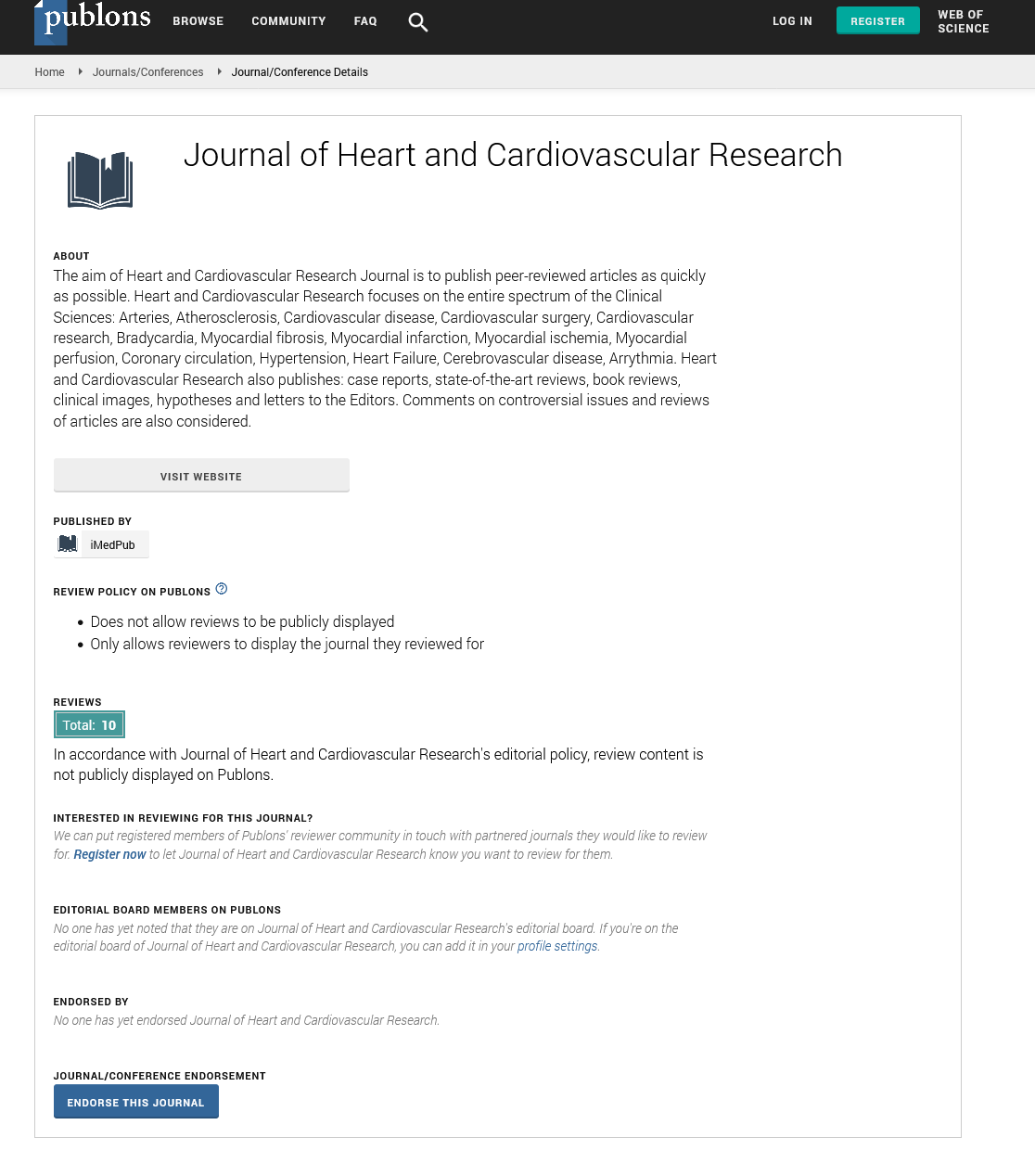ISSN : ISSN: 2576-1455
Journal of Heart and Cardiovascular Research
Abstract
Heart Congress 2018: Risk stratification for AICD implantation for hypertrophic cardiomyopathy in the young- Charles H Gaymes - University of Mississippi Medical Centre
Introduction:Ninety-five percent of hypertrophic cardiomyopathy are related to defects present in four genes MYH7, MYBPC3, TNNT2 and TNN13. The cause of sudden cardiac arrest (SCA) in hypertrophic cardiomyopathy has not been determined. The guidelines for risk stratification for SCA and AICD implant from the ACC and AHA are not based on any large studies in children. Anecdotal cases do not support their usefulness. We report our data base analysis of a cohort of patients with HCM followed at a single center from 1995-2017 and found no consistent risk factors for SCA. Hypertrophic cardiomyopathy (HCM), a genetic sarcomeric disorder associated with myocyte disarray and scar deposition, is intimately linked to sudden cardiac death (SCD) due to malignant ventricular arrhythmias. In the first modern published description of the disease in 1958, Dr Donald Teare describes the case of a 14-year-old male who collapsed while being chased around his school’s playground. He was reported to have been having ‘blackout episodes’ for months. He had seen physicians and the only abnormal finding elicited was a third heart sound and a soft systolic murmur. As there was no evidence of seizure activity, he was advised to continue his daily activities without restriction. After collapsing while playing, he was pronounced dead on arrival at the hospital and his autopsy was remarkable for massive septal hypertrophy. Dr Teare’s report described seven more cases of young adults all who suddenly collapsed without warning with similar findings on autopsy. Since 1958 our understanding of HCM has markedly improved, but up to the 1980s little progress had been made in preventing SCD. The advent of the implantable cardioverter-defibrillator (ICD) has drastically changed our ability to prevent SCD. In this review we discuss our current epidemiological, genetic and structural understanding of the link between HCM and SCD. We also discuss the role of modern ICD therapy in the primary prevention of sudden death in patients with HCM. HCM is a heterogeneous disease that is classically transmitted in an autosomal dominant fashion. HCM often arises from mutations in genes responsible for the formation of cardiac sarcomeres. Sarcomeric mutations, initially discovered in the 1980s, are found in up to 70 % of patients with a family history of HCM.The most common mutations are in the myosin heavy chain (MYH7 gene) and myosin binding protein C (MYBPC3 gene). There is marked heterogeneity in penetrance, however, and a poor understanding of how the different genotypes manifest as HCM phenotypes. Currently, there is minimal evidence to support the use of genetic testing to identify patients who are at high risk of SCD. Small studies have found that patients with a more malignant inheritance of their mutations (i.e. homozygous mutations) as well as the presence of a MYH7 gene mutation have increased rates of heart failure. Methods: We reviewed our database for all hypertrophic cardiomyopathy patients followed by pediatric cardiac electrophysiology. Data was tabulated for presenting symptoms, EKG finds, ambulatory monitoring, and echocardiogram measurements. In decreased patients, autopsy results were also compiled and tabulated. Results: Total of 57 candidates (37 male and 20 female) of age 1-29 (mean 19) years with 3 syncope 6 SCA as first symptom (3 resuscitated) and palpitations 20/57 were included in the study. 7/57 had family history of HCM 3/57 (SCA). 16/57 had no sustained VT (ambulatory monitor). 5/47 AICD received appropriate therapy (only 1/5 met guidelines for AICD) 2/47 patients inappropriate therapy. 1/47 with AICD died from ventricular fibrillation (patient within guidelines for AICD).
Conclusion: We could not identify specific criteria for risk stratification of SCA/AICD implantation in our population of patients with hypertrophic cardiomyopathy. The current guidelines are not sensitive or specific enough in children to guide AICD implant. The risk for SCA likely resides in the cellular dysfunction and may be related to the genetics. Until larger studies could better risk stratify SCA the decision for AICD should be discussed with the patient and a decision made even if the guidelines are not met.
Author(s): Charles H Gaymes
Abstract | PDF
Share This Article
Google Scholar citation report
Citations : 34
Journal of Heart and Cardiovascular Research received 34 citations as per Google Scholar report
Journal of Heart and Cardiovascular Research peer review process verified at publons
Abstracted/Indexed in
- Google Scholar
- Sherpa Romeo
- China National Knowledge Infrastructure (CNKI)
- Publons
Open Access Journals
- Aquaculture & Veterinary Science
- Chemistry & Chemical Sciences
- Clinical Sciences
- Engineering
- General Science
- Genetics & Molecular Biology
- Health Care & Nursing
- Immunology & Microbiology
- Materials Science
- Mathematics & Physics
- Medical Sciences
- Neurology & Psychiatry
- Oncology & Cancer Science
- Pharmaceutical Sciences
